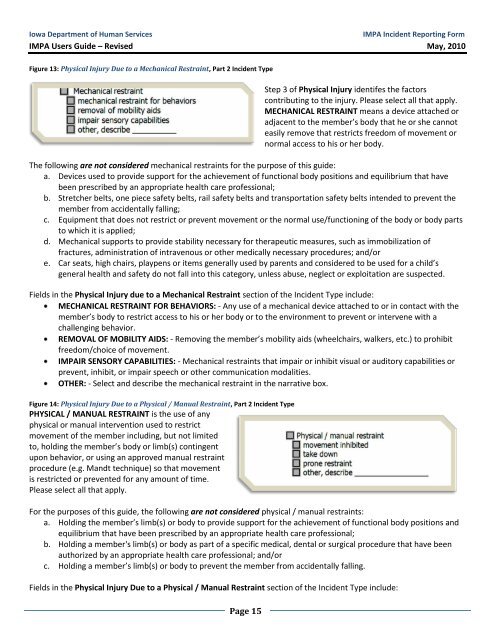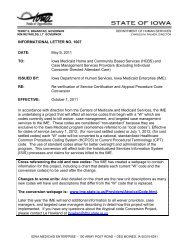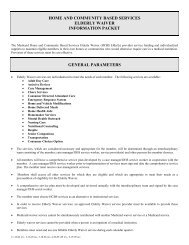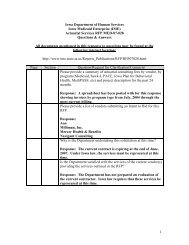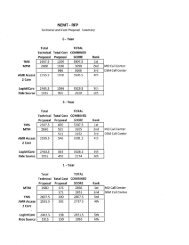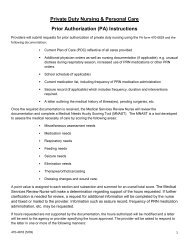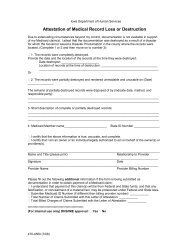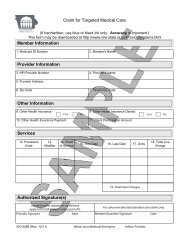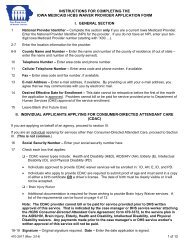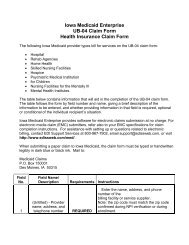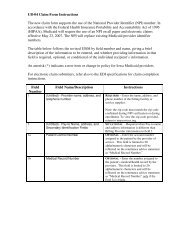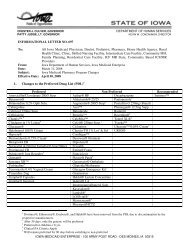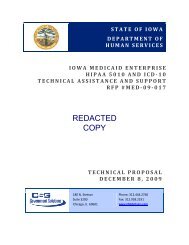Critical Incident Report User Guide Form 470-4698 - Iowa Medicaid ...
Critical Incident Report User Guide Form 470-4698 - Iowa Medicaid ...
Critical Incident Report User Guide Form 470-4698 - Iowa Medicaid ...
- No tags were found...
Create successful ePaper yourself
Turn your PDF publications into a flip-book with our unique Google optimized e-Paper software.
<strong>Iowa</strong> Department of Human ServicesIMPA <strong>Incident</strong> <strong>Report</strong>ing <strong>Form</strong>IMPA <strong>User</strong>s <strong>Guide</strong> – Revised May, 2010Figure 13: Physical Injury Due to a Mechanical Restraint, Part 2 <strong>Incident</strong> TypePage 15Step 3 of Physical Injury identifes the factorscontributing to the injury. Please select all that apply.MECHANICAL RESTRAINT means a device attached oradjacent to the member’s body that he or she cannoteasily remove that restricts freedom of movement ornormal access to his or her body.The following are not considered mechanical restraints for the purpose of this guide:a. Devices used to provide support for the achievement of functional body positions and equilibrium that havebeen prescribed by an appropriate health care professional;b. Stretcher belts, one piece safety belts, rail safety belts and transportation safety belts intended to prevent themember from accidentally falling;c. Equipment that does not restrict or prevent movement or the normal use/functioning of the body or body partsto which it is applied;d. Mechanical supports to provide stability necessary for therapeutic measures, such as immobilization offractures, administration of intravenous or other medically necessary procedures; and/ore. Car seats, high chairs, playpens or items generally used by parents and considered to be used for a child’sgeneral health and safety do not fall into this category, unless abuse, neglect or exploitation are suspected.Fields in the Physical Injury due to a Mechanical Restraint section of the <strong>Incident</strong> Type include:MECHANICAL RESTRAINT FOR BEHAVIORS: - Any use of a mechanical device attached to or in contact with themember’s body to restrict access to his or her body or to the environment to prevent or intervene with achallenging behavior.REMOVAL OF MOBILITY AIDS: - Removing the member’s mobility aids (wheelchairs, walkers, etc.) to prohibitfreedom/choice of movement.IMPAIR SENSORY CAPABILITIES: - Mechanical restraints that impair or inhibit visual or auditory capabilities orprevent, inhibit, or impair speech or other communication modalities.OTHER: - Select and describe the mechanical restraint in the narrative box.Figure 14: Physical Injury Due to a Physical / Manual Restraint, Part 2 <strong>Incident</strong> TypePHYSICAL / MANUAL RESTRAINT is the use of anyphysical or manual intervention used to restrictmovement of the member including, but not limitedto, holding the member’s body or limb(s) contingentupon behavior, or using an approved manual restraintprocedure (e.g. Mandt technique) so that movementis restricted or prevented for any amount of time.Please select all that apply.For the purposes of this guide, the following are not considered physical / manual restraints:a. Holding the member’s limb(s) or body to provide support for the achievement of functional body positions andequilibrium that have been prescribed by an appropriate health care professional;b. Holding a member's limb(s) or body as part of a specific medical, dental or surgical procedure that have beenauthorized by an appropriate health care professional; and/orc. Holding a member’s limb(s) or body to prevent the member from accidentally falling.Fields in the Physical Injury Due to a Physical / Manual Restraint section of the <strong>Incident</strong> Type include:


